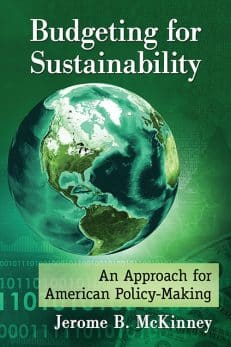Budgeting for Sustainability
An Approach for American Policy-Making
$29.95
In stock
About the Book
This book provides critical insights about how U.S. policymaking is likely to be imperiling America’s future, and how only the most efficient and productive organizations and governments will reap globalization’s greatest rewards. Vital areas such as vocational training, manufacturing, infrastructure, sustainable debt creation and the STEM worker shortage crisis are extensively examined and innovative solutions are proposed. Twenty-seven common-good indicators are presented for assessing policymaking, aimed at providing maximum transparency and accountability.
Instructors considering this book for use in a course may request an examination copy here.
About the Author(s)
Bibliographic Details
Jerome B. McKinney
Format: softcover (6 x 9)
Pages: 246
Bibliographic Info: 9 photos, notes, bibliography, index
Copyright Date: 2017
pISBN: 978-1-4766-6870-3
eISBN: 978-1-4766-2979-7
Imprint: McFarland
Table of Contents
Acknowledgments vi
Preface 1
1. America’s Vulnerability: A Reality Check 7
The Guiding Pursuit 11; Environmental Performance and Infrastructure Ranking 12; Globalization and the Sustainability Imperative 13; Defining Sustainability 13; Attributes of Sustainable Companies 15; The Innovation Imperative 16; Sustainable Competitiveness Among Nations 17; Math, Science, Reading and Engineering 21; U.S. STEM Programs: Foreign Student Dependence 22; Research and Development Expenditures 22; STEM Area for Action and Leadership 23; High Technology Exports 26; Quality of Higher Education 26; Patents and Manufacturing 27; Ease of Doing Business 28; Tax and Environmental Sustainability 29; Ramifications of the Great Recession on Sustainability 31; Retooling the U.S. Economic Engine 32
2. The Sustainability Budget Model 34
The State of Budget Making in the U.S. 35; Sustainability Budgeting: An Early Attempt 36; Green Sustainability Budget 37; Green Budgets vs. Fiscal Sustainability Budgets 38; Fiscal Models of Sustainability Analysis 40; Sustainability Budgeting and Public Finance 41; Instant Transparency and Accountability 42
3. Comparing Critical Selected Indicators 48
Income Inequality 52; Life Expectancy 53; High Tech Exports 55; Total Corporate Tax Rate 55; Sustainability in Industrializing and Industrial Economies 56; Selected Indicators: Industrializing and Industrialized Countries 57; Competitiveness 59; OECD Better Life Initiative 61
4. Infrastructure and Sustainability Budgeting 64
Hard and Soft Infrastructure 66; U.S. Infrastructure: Implications for Competitiveness 67; Four Opinions on U.S. Infrastructure Competitiveness 69; Transportation Infrastructure Report, 2012 73; World Infrastructure Rankings 80
5. The Training Imperative and Sustainability 84
Importance of Training 84; Sustainability Budgeting and Training 84; The German Training Model 86; Vocational Education in Finland: Preparation for the Global Economy 88; Singapore: Sustainable Training for Competitiveness 89; Training in the European Union (EU) 91; Business and Union Unity on Training 92; EU Impact of Education and Training in Ireland 93; Lifelong Learning in the EU 94; Training and Inclusiveness 95; European Union: Linking Inclusiveness to Sustainability 97; China and Vocational Education 98; Capable U.S. Workforce 99; U.S. Education and the Job Market 102; Closing the Skills Gap 103; U.S. Vocational Education Training 104; Apprenticeship: Some Perspectives 108; The Critical Need: A Training Development Bank 110; The U.S. Training and Development Bank 114
6. Manufacturing and the Sustainability Imperative 115
Importance of Manufacturing 115; Manufacturing Competitiveness 117; International Competitiveness 118; Drivers of Global Manufacturing Competitiveness 119; U.S. Rating on the Global Manufacturing Index 119; Consistent Characteristics of Competitive Manufacturing 120; America’s Manufacturing Renaissance 121; U.S. Companies Reshoring: The Extent of It 123; Sustainability and Manufacturing 125; Impact of Public Policy on Competitiveness 127; Tax Policy as an Instrument for Revitalizing U.S. Manufacturing 130; A National Manufacturing Strategy 131; Sustainability Challenges 132
7. Sustainability Budgeting and Multinational Companies 136
What Is a Multinational Company (MNC)? 137; Roles of MNCs 137; Multinational Guiding Philosophy 138; Selected MNC Philosophy/Guidelines 139; Corporate Social Responsibility (CSR) 140; MNCs’ Operating Perspectives vs. Home Country 142; Sources of Conflict Between MNCs and Host Country 143; Ways MNCs Can Influence Host Countries 144; MNCs and Foreign Policy 144; Multinationals and the U.S. Economy 145; Multinationals’ Pay and Working Conditions 145; Multinationals and Sustainability 146; Sustainability and MNCs Battle for Talent 148; Six Developing Trends in Sustainability 150; Sustainability and Innovation 154
8. Sustainability Budgeting and Debt Creation 158
Nature and Magnitude of U.S. Debt 158; Advantages of Deficit Spending 161; Owners of the U.S. Public Debt 161; Rising Government Debt: Public Policy by Default 163; Intentional Incurrence of Deficit 164; Debt Limitation as a Political and Backdoor Partial Check 164; California’s Proposition 13 Legacy and the Drivers for Debt Creation 166; What Is Proposition 13? 167; Delinking Spending and Revenue Requirements 168; Debt Creation as the Imperative for Prosperity 169; Federal Capital Budgeting 171; Pros on Federal Capital Budgeting 172; Cons on Federal Capital Budgeting 174; Array of Forces against a Federal Capital Budget 175; Concerns About Adopting a Capital Budget 177; Debt Creation and Sustainability 178; Debt Sustainability Assessment 178; Defining Fiscal Debt Sustainability 179; Fiscal Sustainability Report 180; EU Sustainability Debt Pact 181; Achieving Sustainable Debt Targets in OECD Countries: Empirical Findings 182; Debt Creation and Crowding Out Effects 183; Some Types of Crowding Out 184; Debt Burden 186; Quality Public Debt and Sustainability 187; Actual versus Real Deficit 187; When Public Debt Is Good 188; When Public Debt Is Bad 189; The Simpson-Bowles Plan 190; Deleveraging: Post–Great Recession 192; Concluding Observations 193
Summary and Concluding Observations 197
The Education Conundrum 198; Training Imperative Recommendations 199; The Need for a Training Development Bank 200; Infrastructure Status and Recommendations 201
Chapter Notes 207
Bibliography 223
Index 233





